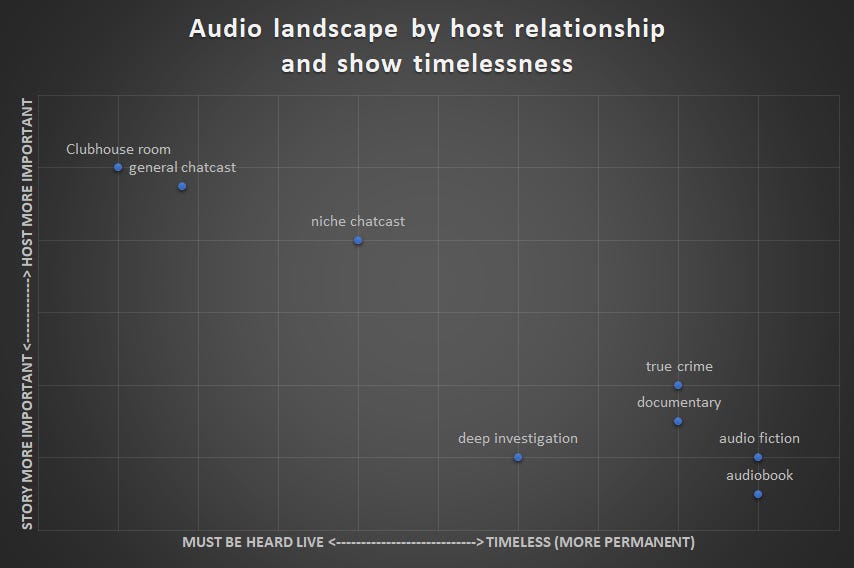Here's what the future of podcasting looks like
Presenting a graph of show types that helps us see how audio might form camps as money flows in from the world of venture capital
Good morning. Thanks for reading my story last week about the terrible accident and tragedy involving my friends. I can see the effects of the tragedy in every face in town. Several friends met outdoors near the river last week to commemorate Adam and it was wonderful to see so many people I haven’t seen in a long time. Everyone knew and loved Adam.
Also Peter seems to be doing well. He’s making progress toward healing and I can’t wait for him to be able to go home from the hospital and to see him in person.
This week I’m back to writing about podcasts.
When I concentrate hard I can think back to the end of last year. We were all talking about the wave of consolidation that had just concluded with the Amazon’s purchase of the giant podcast network Wondery. The big question on everyone’s mind was whether some company would arise as the YouTube or Netflix of podcasting.
Now that that’s long behind us, our conversations have turned to the audio hangout company called Clubhouse and the recent announcement of a Clubhouse competitor called Fireside (the second podcasting company wanting images of camping or FDR in your brains).
Collectively we have the same questions. Will one of these become the Netflix or YouTube of podcasting? Is podcasting ruined?
Podcast industry writers are quick to say that Clubhouse is not podcasting, that it doesn’t ruin anything, and I’ve enjoyed the discourse. Everyone has had good insights. Today I’m going to try to synthesize those insights and add my own point of view based on a conversation with Chris Hickman last Monday that was not recorded or Clubhoused.
What we saw is opposite of consolidation. Instead of everyone using Apple Podcasts, there are more and more places with different types of audio to go to. It’s a separation of the different kinds of audio into different camps. And I think once these camps begin to form, they get a kind of permanence about them. To understand what I mean by camps, let’s look at social media. We have Facebook, Instagram, Snapchat, TikTok, LinkedIn and Twitter. Each of those probably evokes a certain type of user and certain type of content in your mind. And as much as one might try to copy the features of another—Linked in just added stories 🤣 (btw go read that article. It is better than anything I’ve ever written)—the brand is already solidified. It can’t be changed.
I believe we’ll see the same kind of brand cementation in audioland. So for fun, I’ve created a graph that I think helps us see where things will land. The X-Axis is about the longevity of the work. Must it be heard live or can you listen in 10 years and enjoy it just as much? The Y-Axis is about the importance of the host. Does the person speaking feel like someone you know and have inside jokes with, or, so long as the person doesn’t put you to sleep with a monotone, you don’t care who’s speaking as long as the story is good?
By spreading out different kinds of audio into where they land on this spectrum, we can see opportunities to group them into businesses that market to the types of people that listen to them.
Since the graph doesn’t speak for itself, here’s a quick blurb on each type of audio I included and why it lands where it lands.
Audiobooks: These are Audible’s domain, and they have a superb moat built on deals with publishers. They’re in the lower right because books are usually purpose-built to stand the test of time, and only very hardcore people develop preferences for specific book narrators.
Narrated non-fiction: True crime podcasts, documentary podcasts, journalistic deep dive podcasts, and others like these do engender more of a relationship between the host and the listener, but the story is more important than the host. These shows tend to be expensive to make (like audiobooks), and some of the investment is justified by the fact that they have a long, sometimes indefinite, shelf life. For now these are squarely in traditional podcast land—maybe because of This American Life’s decision in 2006. Additionally, possibly because of some nice features that Spotify has for organizing and recommending them, listenership of these is migrating from Apple Podcasts to Spotify.
Niche chat-casts: They’re not scripted but they dive deep into something specific. They include everything from tech podcasts like my dear personal favorite Mobycast to stuff like Sawbones, Ologies, or Around the Rim. This means that the hosts of the good ones are usually experts in the field or great at interviewing the experts, and the fact that they contain niche information makes them have a longer shelf life than general chat-casts. Currently these are squarely in the traditional podcast category and shared between Apple and Spotify. I’ll wildly guess that Spotify’s recommendation system for these is not as well tuned as it is for narrated nonfiction, so they’re less likely to pull from Apple listenership. And if you believe that newsletter guessery, then stick with me while I say some of the smaller podcast players do well with these. For example, I know several tech people that swear by Overcast for their tech shows. Maybe Overcast should lean in.
General chat-casts: From political analysis, to comedy, to pop culture, these almost always have a very short shelf life, but what they have instead is true fans of the hosts. If the fans of these shows listen to the back catalog, it’s because of that love. The ones of these that already exist as podcasts and are already successful are unlikely to find a reason to move their shows to a place like Clubhouse—especially because of the 5000 person room limit on that particular platform. But in terms of content and people’s relationship to it, they are swimming in the same pool as successful Clubhousers. And new shows that are essentially this genre will be born and flourish on Clubhouse precisely because Clubhouse gives them a way to get out from under the shadows of the existing successful chat-casts.
Hey I wanna be a podcaster podcasts: This one’s not even on the diagram because these are the shows that people don’t actually listen to—the random general public that thinks they could be a podcast star without putting in any real work. These are the people that join multi-thousand member Facebook groups and ask, by way of introduction, how to monetize their show. They are fired up and ready for Clubhouse. To the extent that some part of the podcast industry is funded by these folks, Clubhouse is a risk to them.
Born on Clubhouse “podcasts”: A new type of ephemeral audio is being born on Clubhouse. If you’re tired of the podcast cliché that podcasting is an intimate medium, close your eyes so that you don’t read that Clubhouse is even more intimate. The listeners are in the room when the words are spoken. The parasocial relationship listeners develop with the hosts is that much closer to an actual real relationship! Clubhouse owns this category and there’s nothing that podcasting can do about it. If what you want to hear is the person you stan having a normal one, then Clubhouse is absolutely the best place for it. The newly announced Fireside app with funding from Cuban may take a shot at dethroning Clubhouse for this kind of audio, but I think it’s already too late. And the fact that the founders didn’t even bother to do a quick market survey before telling the media about their big score with Cuban doesn’t give me confidence that they understand the industry they’re entering (not to mention wtf with that logo?)
I think there’s room for each of the points on the graph including ones I left out like live sports, meditation pods, audio art pods, etc, to have their own whole space that really brings out their best qualities. The best software for browsing chat-casts would feature personalities, while the best for narrative non-fiction would feature storylines and storytelling styles, and the best software for niche chat-casts would feature signals of expertise.
In my vision of an ideal world, this is already happening and will continue to happen. There’s also some danger of an actor with extreme competitive intentions scooping several camps up by throwing money at creators, forming a bubble, and ruining them.
And, ok fine, Andreessen Horowitz money in the game does make me a tiny bit nervous. They were investors in Instagram, Facebook, Pinterest, and Zynga. It’s not controversial to say that they deeply understand how to turn people’s attention into money. They’ve got the playbook, and I expect them to use it. Clubhouse didn’t take their investment to be principled.
We live in a time of a bottomless desire among people to be famous, to go viral, and to get rich. Clubhouse is tapping directly into this desire, and that’s why A16Z invested.
Fortunately, Clubhouse is not well positioned to scoop up several of the nodes in my graph. Clubhouse’s draw is the SnapChat-like temporary nature of things, and that’ll keep them in the top left quadrant. Big stars wouldn’t be doing Clubhouse rooms if they knew everything they were saying was being recorded and could be played back later. It’s a core part of their identity and marketing that works.
Another way of thinking about this is that Clubhouse can’t compete directly with narrative nonfiction or audiobooks any more than Twitter can compete directly with actual books. Sure Twitter can and does cut into the overall human number of reading minutes, and Clubhouse will cut into the overall human number of listening minutes, but both of those buckets of minutes are elastic enough that this is not a zero sum game.
As these camps of audio content form and crystalize, it’s not clear exactly what will happen, but there is one thing of which I am certain. People’s attention will follow the content they want. It’s that old adage that content is king. Clubhouse is currently the best situated for parasocial relationships with stars. And unless they can make themselves the best place for other types of content, they will not monopolize podcasting.
Have a great week! Thanks for reading. Praise the hard work of your creative peers!
—Jon Christensen



